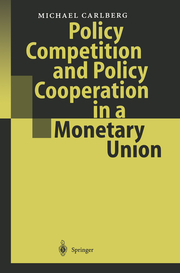Policy Competition and Policy Cooperation in a Monetary Union von Michael Carlberg
Policy Competition and Policy Cooperation in a Monetary Union
ISBN/EAN: 9783642534775
Sprache: Englisch
Umfang: xvi, 288 S.
Einband: kartoniertes Buch
Erschienen am
01.08.2012
Auf Wunschliste
European monetary unification seems to be one of the most important events in international monetary affairs since the breakdown of Bretton Woods. It pos es a major challenge to central banks, governments, and labour unions. It opens up new fields of economic research that are both intriguing and fascinating. European Monetary Union amounts to a switch of regime. Surely the Mundell Fleming model of the open economy does no longer apply to Germany or France. The effects of shocks and policies on output and prices should have changed dramatically in size. Some of them should even work in the opposite direction now. The present book is part of a larger research project on monetary union, see Carlberg (1999, 2000, 2001, 2002, 2003). Some parts of this project were presented at the World Congress of the International Economic Association in Lisbon. Other parts were presented at the Macro Study Group of the German Economic Association, at the Annual Meeting of the Austrian Economic Association in Klagenfurt, at the Pass au Workshop on International Economics, at the Halle Workshop on Monetary Economics, and at the Research Seminar on Macroeconomics in Freiburg. Moreover, book reviews were published in the Economic Journal, Kyklos, the Journal of Economics, and the Journal of Economics and Statistics.
Inhaltsangabe1. Subject and Approach.- 2. The Monetary Union of Two Countries: Basic Models.- 3. The Monetary Union of Two Countries: Intermediate Models.- One. The Monetary Union of Two Countries: Basic Models.- 1. Monetary Policy in the Union.- 1. The Model.- 2. Some Numerical Examples.- 2. Fiscal Competition between Germany and France.- 1. The Dynamic Model.- 2. Some Numerical Examples.- 2.1. Unemployment in Germany Equals Unemployment in France.- 2.2. Unemployment in Germany Exceeds Unemployment in France.- 2.3. Unemployment in Germany Exceeds Overemployment in France.- 2.4. Unemployment in Germany Equals Overemployment in France.- 3. Fiscal Cooperation between Germany and France.- 1. The Model.- 2. Some Numerical Examples.- 4. Competition between the Union Central Bank, the German Government, and the French Government.- 1. The Dynamic Model.- 2. Some Numerical Examples.- 2.1. Unemployment in Germany and France.- 2.2. Another Interpretation.- 2.3. Inflation in Germany and France.- 5. Cooperation between the Union Central Bank, the German Government, and the French Government.- 1. The Model.- 2. Some Numerical Examples.- 2.1. Unemployment in Germany and France.- 2.2. Inflation in Germany and France.- 6. Independent Central Bank, Fiscal Cooperation between Germany and France.- 1. Unemployment in Germany and France.- 1.1. The Model.- 1.2. Some Numerical Examples.- 2. Inflation in Germany and France.- 2.1. The Model.- 2.2. Some Numerical Examples.- 7. A Synopsis of the Basic Models.- Two. The Monetary Union of Two Countries: Intermediate Models.- 1. Fiscal Competition: A General Model.- 2. The Union Countries Differ in Size.- 1. Monetary Policy in the Union.- 2. Fiscal Competition between Germany and France.- 3. The Union Countries Differ in Behaviour.- 1. Monetary Policy in the Union.- 2. Fiscal Competition between Germany and France.- 4. Simultaneous and Independent Decisions.- 5. Gradualist Policies.- 6. Alternative Targets of the Union Central Bank.- 7. The German Government Targets Overemployment.- 8. No Spillovers of Fiscal Policy.- 1. Fiscal Competition between Germany and France.- 2. Competition between the Union Central Bank, the German Government, and the French Government.- 9. Positive Spillovers of Fiscal Policy.- 1. Fiscal Competition between Germany and France.- 2. Fiscal Cooperation between Germany and France.- 3. Competition between the Union Central Bank, the German Government, and the French Government.- 4. Independent Central Bank, Fiscal Cooperation between Germany and France.- Three. The Monetary Union of Two Countries: Advanced Models.- 1. Cold-Turkey Policies: Sequential Decisions.- 2. Cold-Turkey Policies: Simultaneous Decisions.- 1. The Dynamic Model.- 2. A Numerical Example.- 3. Gradualist Policies: Sequential Decisions.- 1. The Dynamic Model.- 2. A Numerical Example.- 4. Gradualist Policies: Simultaneous Decisions.- 1. The Dynamic Model.- 2. A Numerical Example.- 5. Monetary, Fiscal and Wage Competition.- 1. The Government Closes the Output Gap by 100 Percent, the Labour Union Closes the Output Gap by 100 Percent.- 2. The Government Closes the Output Gap by 40 Percent, the Labour Union Closes the Output Gap by 40 Percent.- 3. The Government Closes the Output Gap by 20 Percent, the Labour Union Closes the Output Gap by 60 Percent.- 4. The Government Closes the Output Gap by 60 Percent, the Labour Union Closes the Output Gap by 60 Percent.- 5. The Government Closes the Output Gap by 40 Percent, the Labour Union Closes the Output Gap by 80 Percent.- Four. The Monetary Union of n Countries.- 1. The Monetary Union of Three Countries.- 1. Monetary Policy in the Union.- 2. Fiscal Competition between Germany, France and Italy.- 3. Fiscal Cooperation between Germany, France and Italy.- 4. Monetary and Fiscal Competition.- 5. Independent Central Bank, Fiscal Cooperation between Germany, France and Italy.- 2. The Monetary Union of Four Countries.- Five. Rational Policy Expectations.- 1. Rational Policy Expectations in Germa






